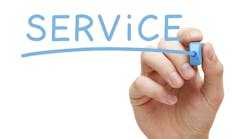A growing number of companies see the service supply chain as a way to drive revenue rather than just a cost of doing business, according to PwC’s 17th Annual CEO survey, “Service supply chain as a source of competitive advantage.” This benchmark study found that 44% of respondents to its survey drive revenue from finding innovative ways to manage warranty costs, improve service supply chain operations, and remarket repaired units.
According to this survey, 71% of U.S. CEOs are planning to remake their fulfillment and service supply chains. Also, there is a significant cost gap between average and top performing OEMs in this regard. For example, in the high technology market, where every point of margin is important, the difference in service supply chain cost as a percent of product revenue is 2.9 points.
The study cites three sources of leverage for manufacturers:
1) broadening service operation options for customers,
2) engaging service supply chain partners in innovating operational practices,
3) focusing on end-to-end performance quality and management.
Delivering faster turnaround time for repair and product upgrades was seen as a particularly powerful advantage. This strategy starts in the design process, where a product is “designed for service.” Modularity of repairable parts enables a higher percentage of “same visit” walk in center repairs and customer completed repairs. Both reduce logistics and field service costs and the lead time to getting product back in use.
Many OEMs provide free repairs for products that are not qualified for a warranty entitlement because the processes are not well defined or reinforced across call center and repair center or field service partner staff. However, poorly planned services are not necessarily a competitive advantage. In fact, this report observes that with reasonable pricing, charging for out of coverage repairs is generally accepted by customers and has no negative impact on future buying decisions.
“Few companies have or use a robust “post-sale service readiness” plan as they manage their supply chain set-up and sales and marketing readiness plans,” this report concludes. “Fewer still think to align the service supply chain set-up with local customs and tax regulations or with the local basis of competition in cases of a new country expansion. The level of thought and preparation put into the network design choices for service operations directly correlates to how well positioned these operations are for a high quality and cost effective experience that can quickly impact the brand value proposition.”
Material Handling Under Warranty
In related news, material handling equipment has been officially recognized as its own category among warranty professionals. According to “Warranty Week,” a newsletter serving that audience, material handling has been poorly represented as an industry category among those who study warranty expense rates. For example, most forklifts have been counted as vehicles in other industry categories, and much of the pipelines and conveyor belts used in the mining/petroleum and food/farm industries have been counted as part of the equipment used in those respective industries. That hasn’t left much else to be called "material handling equipment," Warranty Week states.
Its analysts have identified 42 companies whose primary industry category is "Material Handling," plus an additional 19 that fit better into a different primary category, but also have a significant presence in the material handling industry. For instance, Columbus McKinnon Corp. is counted primarily as a supplier of building materials. Hyster-Yale Materials Handling Inc., Astec Industries Inc., and Terex Corp. are in the large vehicle category with other automotive OEMs. Manitowoc Co. Inc. is counted primarily in the appliance industry. And both Textron Inc. and FMC Technologies Inc. are counted primarily as aerospace companies.
Until recently, warranty professionals tracked the product warranty expenses of U.S.-based manufacturers in 14 different industry sectors plus a 15th called ‘Other.” Material handling is now one of three new categories. The others are “Security Equipment" and “Sports Equipment.”





